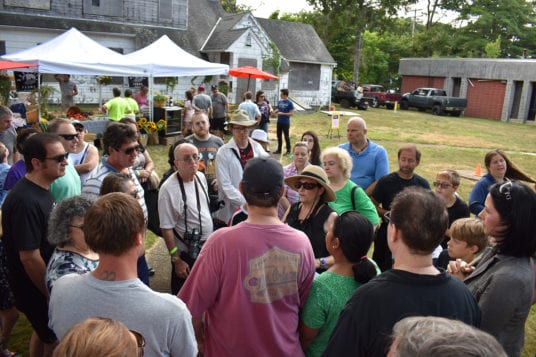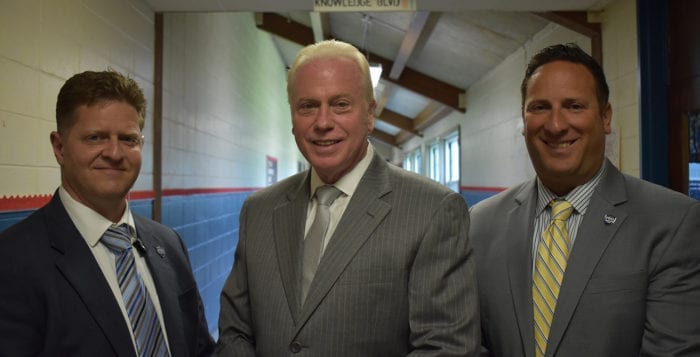Guards say they’re settling in to posts in the district, will be brought back in September
“Guns in schools.”
Even to Mount Sinai Superintendent Gordon Brosdal it sounds like a foreign concept, but since March, the district has had four armed security guards stationed in all school buildings.
“When you look at what’s going on around you — you can’t ignore it,” Brosdal said. “Are we going to wait around for something before it happens?”
It has been a few months since the district hired its guards from Hauppauge-based Pro Protection Security Inc., and with the school year now over, those guards, such as elementary school guard John, said they have settled into a routine.
“The students and staff see me every day — the same face — and they get used to me. I think that’s really important for what I’m here to do.”
— John, security guard
“I man the hallways, make sure no unauthorized persons come in around the building, are going outside unauthorized — I check the doors, make sure they’re locked,” John said. “The students and staff see me every day — the same face — and they get used to me. I think that’s really important for what I’m here to do.”
Mount Sinai School District asked that the last names of the guards and their exact locations inside the school not be disclosed.
Despite the huge push for increased school security after the Feb. 14 shooting in Parkland, Florida, only four of 69 districts in Suffolk County have opted to hire armed guards — Center Moriches, Hauppauge, Miller Place and Mount Sinai — as far as TBR News Media has identified. Other districts have publicly expressed interest in the possibility, but to date those are the only three.
It’s also a commitment in financial terms. Hauppauge is paying $300,000 for its contract to hire its armed security guards and Mount Sinai’s 2018-19 adopted budget included $400,000 in security funding, which was $305,000 more than the 2017-18 school year.
For the last months of the 2017-18 school year, four guards stood at attention around the Mount Sinai campus, which includes the elementary, middle and high schools. Each was dressed in a clean suit with an earpiece microphone in his ear and a concealed gun at his side. Though Christopher Innace, the CEO of Pro Protection, said the important thing in hiring these guards wasn’t necessarily about the heat they were packing, but how they could interact with students.
“In the case of the elementary school we wanted someone who had a bubbly personality — someone who is outgoing, is smiling — things of that nature,” Innace said. “We also train our officers to say hello, good morning and be interactive with the parents, the community and visitors. That’s just the impression we want to give.”
Innace said each of the security guards is a retired police officer. Security guard Dave mans the campus gate, Paul is stationed at the high school, John serves the elementary school and helps Don at the middle school.
“The kids have been excellent — they come up to me and shake my hand, they give me a high five,” John said. “You didn’t get that sense of it so much working [as an officer] in the city, but here it seems everyone is overwhelmingly appreciative, and it’s a nice feeling.”
Innace and vice president of Pro Protection Christopher Alger both said the recruitment process for the guards in Mount Sinai was rigorous and included background checks. The district specifically didn’t look for prison guards or people that Innace called the “bouncer” type. All the guards at Mount Sinai are trained in what Innace referred to as “verbal judo,” or using speech to de-escalate tense situations.
In the months leading up to the final decision to hire armed guards in March, the Mount Sinai community was divided on the issue, and many remain so. Some felt the armed guards were an absolute necessity and the only way to really ensure a safe school.
“I fully support it and I sleep better at night as a result of it,” Mount Sinai resident Heather Janae said. “When I pick up my elementary-aged daughter from school every day and see the armed guard standing there I am content. It’s a very sad and unfortunate need, but in my opinion, it’s a need.”
Others in the community said a gun in school, no matter who was holding it, could lead to danger and violence.
“It’s a travesty — more guns is not the answer to too many guns, especially in or near our schools where there appears to be the most hideous shootings,” Mount Sinai resident Ron DiGennaro said. His daughter graduated from Mount Sinai High School in 2002.
Some residents were concerned how the guards would respond to kids with mental and physical disabilities. While Brosdal said there haven’t been any problems in those cases, he said he plans to host training with the guards and the school’s special education teachers designed to teach the guards how to interact with students who have special needs.
“It’s a travesty — more guns is not the answer to too many guns, especially in or near our schools where there appears to be the most hideous shootings.”
— Ron DiGennaro
Since the Parkland shooting, security has become a greater concern for every local school district. Shoreham-Wading River, Smithtown and Kings Park school districts are building security vestibules in all school buildings over the summer. Smithtown is receiving unarmed security guards at the elementary schools, and the Huntington School District is replacing old doors and is hiring new security guards.
Along with its armed guards, Mount Sinai is using money from its unassigned fund balance to finance renovations to the school’s perimeter fencing and replacing some of the glass fronts seen at the high school.
Alger, who himself is a retired NYPD detective first grade, said the armed guards are just a part of the four D’s of security, which are: detect, deter, deflect and defend. Cameras and staff can act as detection. Layered entrances, such as vestibules, locked doors and perimeter fencing function as deterrents. Glazed and bullet proof glass works well as deflection, but Alger said a guard capable of stopping an intruder is the only real defense against an intruder.
“We’re not running away from the shooter,” Innace said. “We hear shots, we hear a commotion, we are running right to that scene. We’re running right to that shooter.”
Since the beginning of 2018, 26 students have been killed in school shootings through the middle of May, according to fact checking website Politifact. Accounting for school shootings that have not resulted in any deaths, there has been roughly a shooting per week since the start of the year.
Even with armed guards, Alger said there is no guarantee there will be no fatalities in the event of a shooting, but the severity of any shooting is decreased dramatically.
“Armed security isn’t the 100 percent cure but it will 100 percent at least reduce some of these casualties that are taking place,” Alger said.
Brosdal said he feared schools that do not take action now in hiring guards would regret it later.
“It takes one shooting on Long Island, only one, and I believe you’re going to see people clamoring for armed guards,” Brosdal said, then emphasized his point. “You’ll have people clamoring.”
Alger said all four guards have committed to returning to their positions at the start of the next school year in September.
 Laura Sprowls of Setauket recently captured this image of Port Jefferson Harbor from the dock at Danfords Hotel. She writes, “The lighting was strong so I put the sun behind the mini lighthouse to soften the effect and captured a lovely reflection in the calm evening water at the end of a beautiful summer’s day.”
Laura Sprowls of Setauket recently captured this image of Port Jefferson Harbor from the dock at Danfords Hotel. She writes, “The lighting was strong so I put the sun behind the mini lighthouse to soften the effect and captured a lovely reflection in the calm evening water at the end of a beautiful summer’s day.”





 Fiber has very powerful effects on our overall health. A very large prospective cohort study showed that fiber may increase longevity by decreasing mortality from cardiovascular disease, respiratory diseases and other infectious diseases (1). Over a nine-year period, those who ate the most fiber, in the highest quintile group, were 22 percent less likely to die than those in lowest group. Patients who consumed the most fiber also saw a significant decrease in mortality from cardiovascular disease, respiratory diseases and infectious diseases. The authors of the study believe that it may be the anti-inflammatory and anti-oxidant effects of whole grains that are responsible for the positive results.
Fiber has very powerful effects on our overall health. A very large prospective cohort study showed that fiber may increase longevity by decreasing mortality from cardiovascular disease, respiratory diseases and other infectious diseases (1). Over a nine-year period, those who ate the most fiber, in the highest quintile group, were 22 percent less likely to die than those in lowest group. Patients who consumed the most fiber also saw a significant decrease in mortality from cardiovascular disease, respiratory diseases and infectious diseases. The authors of the study believe that it may be the anti-inflammatory and anti-oxidant effects of whole grains that are responsible for the positive results.





























 While the exhibit is named Scenes of Lake Ronkonkoma, Weingartner said it encompasses a range of subjects, including sports and landscapes from other parts of Long Island, including Port Jefferson and Belle Terre. More than 75 framed 8-by-10 prints are on display. His favorite photo features Lake Ronkonkoma at sunset, with two birds and sunlight streaming down to the shore. All the photos were taken with a Nikon D600.
While the exhibit is named Scenes of Lake Ronkonkoma, Weingartner said it encompasses a range of subjects, including sports and landscapes from other parts of Long Island, including Port Jefferson and Belle Terre. More than 75 framed 8-by-10 prints are on display. His favorite photo features Lake Ronkonkoma at sunset, with two birds and sunlight streaming down to the shore. All the photos were taken with a Nikon D600.



